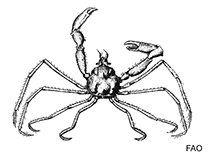Eurypodius latreillii Guérin, 1825
Camouflaged spider crab| Native range | All suitable habitat | Point map | Year 2050 |

|
| This map was computer-generated and has not yet been reviewed. |
| Eurypodius latreillii AquaMaps Data sources: GBIF OBIS |
Google image | No image available for this species;
drawing shows typical species in Inachidae.
Classification / Names Common names | Synonyms | CoL | ITIS | WoRMS
Malacostraca | Decapoda | Inachidae
Environment: milieu / climate zone / depth range / distribution range Ecology
Benthic; depth range 17 - 1490 m (Ref. 87391). Deep-water
Distribution Countries | FAO areas | Ecosystems | Occurrences | Introductions
Southern Oceans.
Length at first maturity / Size / Weight / Age
Maturity: Lm ? range ? - ? cm Max length : 3.9 cm CL male/unsexed; (Ref. 93010); 3.9 cm CL (female); max. published weight: 17.15 g (Ref. 93010); max. published weight: 17.15 g
Life cycle and mating behavior Maturity | Reproduction | Spawning | Eggs | Fecundity | Larvae
Main reference
References | Coordinator | Collaborators
Gorny, M. 1999 On the biogeography and ecology of the Southern Ocean decapod fauna. Scientia Marina 63(1):367-382. (Ref. 87391)
IUCN Red List Status
(Ref. 130435: Version 2025-1)
CITES status (Ref. 108899)
CMS (Ref. 116361)
Threat to humans
Human uses
| FishSource |
Tools
More information
Diet composition
Food consumption
Predators
Max. ages / sizes
Length-weight rel.
Length-length rel.
Length-frequencies
Mass conversion
Abundance
Internet sources
BHL | BOLD Systems | CISTI | DiscoverLife | FAO(Publication : search) | Fishipedia | GenBank (genome, nucleotide) | GloBI | Gomexsi | Google Books | Google Scholar | Google | PubMed | Tree of Life | Wikipedia (Go, Search) | Zoological Record



